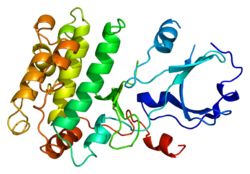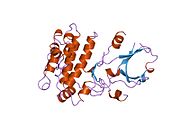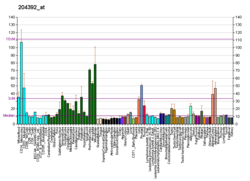CAMK1
| CAMK1 | |||||||||||||||||||||||||||||||||||||||||||||||||||
|---|---|---|---|---|---|---|---|---|---|---|---|---|---|---|---|---|---|---|---|---|---|---|---|---|---|---|---|---|---|---|---|---|---|---|---|---|---|---|---|---|---|---|---|---|---|---|---|---|---|---|---|
 | |||||||||||||||||||||||||||||||||||||||||||||||||||
| |||||||||||||||||||||||||||||||||||||||||||||||||||
| Identifiers | |||||||||||||||||||||||||||||||||||||||||||||||||||
| Aliases | CAMK1, CAMKI, calcium/calmodulin dependent protein kinase I, CaMKI-alpha, CaM kinase I alpha | ||||||||||||||||||||||||||||||||||||||||||||||||||
| External IDs | OMIM: 604998 MGI: 1098535 HomoloGene: 117458 GeneCards: CAMK1 | ||||||||||||||||||||||||||||||||||||||||||||||||||
| |||||||||||||||||||||||||||||||||||||||||||||||||||
| |||||||||||||||||||||||||||||||||||||||||||||||||||
| |||||||||||||||||||||||||||||||||||||||||||||||||||
| |||||||||||||||||||||||||||||||||||||||||||||||||||
| |||||||||||||||||||||||||||||||||||||||||||||||||||
| Wikidata | |||||||||||||||||||||||||||||||||||||||||||||||||||
| |||||||||||||||||||||||||||||||||||||||||||||||||||
Calcium/calmodulin-dependent protein kinase type 1 is an enzyme that in humans is encoded by the CAMK1 gene.[5][6]
Calcium/calmodulin-dependent protein kinase I is expressed in many tissues and is a component of a calmodulin-dependent protein kinase cascade. Calcium/calmodulin directly activates calcium/calmodulin-dependent protein kinase I by binding to the enzyme and indirectly promotes the phosphorylation and synergistic activation of the enzyme by calcium/calmodulin-dependent protein kinase I kinase.[6]
References
- ^ a b c GRCh38: Ensembl release 89: ENSG00000134072 – Ensembl, May 2017
- ^ a b c GRCm38: Ensembl release 89: ENSMUSG00000030272 – Ensembl, May 2017
- ^ "Human PubMed Reference:". National Center for Biotechnology Information, U.S. National Library of Medicine.
- ^ "Mouse PubMed Reference:". National Center for Biotechnology Information, U.S. National Library of Medicine.
- ^ Haribabu B, Hook SS, Selbert MA, Goldstein EG, Tomhave ED, Edelman AM, Snyderman R, Means AR (Sep 1995). "Human calcium-calmodulin dependent protein kinase I: cDNA cloning, domain structure and activation by phosphorylation at threonine-177 by calcium-calmodulin dependent protein kinase I kinase". EMBO J. 14 (15): 3679–86. doi:10.1002/j.1460-2075.1995.tb00037.x. PMC 394442. PMID 7641687.
- ^ a b "Entrez Gene: CAMK1 calcium/calmodulin-dependent protein kinase I".
Further reading
- Bredt DS, Ferris CD, Snyder SH (1992). "Nitric oxide synthase regulatory sites. Phosphorylation by cyclic AMP-dependent protein kinase, protein kinase C, and calcium/calmodulin protein kinase; identification of flavin and calmodulin binding sites". J. Biol. Chem. 267 (16): 10976–81. doi:10.1016/S0021-9258(19)49862-1. PMID 1375933.
- Yokokura H, Picciotto MR, Nairn AC, Hidaka H (1995). "The regulatory region of calcium/calmodulin-dependent protein kinase I contains closely associated autoinhibitory and calmodulin-binding domains". J. Biol. Chem. 270 (40): 23851–9. doi:10.1074/jbc.270.40.23851. PMID 7559563.
- Liu F, Thompson MA, Wagner S, et al. (1993). "Activating transcription factor-1 can mediate Ca(2+)- and cAMP-inducible transcriptional activation". J. Biol. Chem. 268 (9): 6714–20. doi:10.1016/S0021-9258(18)53308-1. PMID 8384217.
- Chin D, Winkler KE, Means AR (1998). "Characterization of substrate phosphorylation and use of calmodulin mutants to address implications from the enzyme crystal structure of calmodulin-dependent protein kinase I". J. Biol. Chem. 272 (50): 31235–40. doi:10.1074/jbc.272.50.31235. PMID 9395448.
- Hsu LS, Tsou AP, Chi CW, et al. (1998). "Cloning, expression and chromosomal localization of human Ca2+/calmodulin-dependent protein kinase kinase". J. Biomed. Sci. 5 (2): 141–9. doi:10.1007/bf02258368. PMID 9662074.
- Matsushita M, Nairn AC (1998). "Characterization of the mechanism of regulation of Ca2+/ calmodulin-dependent protein kinase I by calmodulin and by Ca2+/calmodulin-dependent protein kinase kinase". J. Biol. Chem. 273 (34): 21473–81. doi:10.1074/jbc.273.34.21473. PMID 9705275.
- Anderson KA, Means RL, Huang QH, et al. (1998). "Components of a calmodulin-dependent protein kinase cascade. Molecular cloning, functional characterization and cellular localization of Ca2+/calmodulin-dependent protein kinase kinase beta". J. Biol. Chem. 273 (48): 31880–9. doi:10.1074/jbc.273.48.31880. PMID 9822657.
- Matsushita M, Nairn AC (1999). "Inhibition of the Ca2+/calmodulin-dependent protein kinase I cascade by cAMP-dependent protein kinase". J. Biol. Chem. 274 (15): 10086–93. doi:10.1074/jbc.274.15.10086. PMID 10187789.
- Hayashi Y, Nishio M, Naito Y, et al. (1999). "Regulation of neuronal nitric-oxide synthase by calmodulin kinases". J. Biol. Chem. 274 (29): 20597–602. doi:10.1074/jbc.274.29.20597. PMID 10400690.
- Hosaka M, Hammer RE, Südhof TC (1999). "A phospho-switch controls the dynamic association of synapsins with synaptic vesicles". Neuron. 24 (2): 377–87. doi:10.1016/S0896-6273(00)80851-X. PMID 10571231. S2CID 14103027.
- Komeima K, Hayashi Y, Naito Y, Watanabe Y (2000). "Inhibition of neuronal nitric-oxide synthase by calcium/ calmodulin-dependent protein kinase IIalpha through Ser847 phosphorylation in NG108-15 neuronal cells". J. Biol. Chem. 275 (36): 28139–43. doi:10.1074/jbc.M003198200. PMID 10874031.
- McKinsey TA, Zhang CL, Lu J, Olson EN (2000). "Signal-dependent nuclear export of a histone deacetylase regulates muscle differentiation". Nature. 408 (6808): 106–11. Bibcode:2000Natur.408..106M. doi:10.1038/35040593. PMC 4459600. PMID 11081517.
- McKinsey TA, Zhang CL, Olson EN (2001). "Activation of the myocyte enhancer factor-2 transcription factor by calcium/calmodulin-dependent protein kinase-stimulated binding of 14-3-3 to histone deacetylase 5". Proc. Natl. Acad. Sci. U.S.A. 97 (26): 14400–5. Bibcode:2000PNAS...9714400M. doi:10.1073/pnas.260501497. PMC 18930. PMID 11114197.
- Hsu LS, Chen GD, Lee LS, et al. (2001). "Human Ca2+/calmodulin-dependent protein kinase kinase beta gene encodes multiple isoforms that display distinct kinase activity". J. Biol. Chem. 276 (33): 31113–23. doi:10.1074/jbc.M011720200. PMID 11395482.
- Condon JC, Pezzi V, Drummond BM, et al. (2002). "Calmodulin-dependent kinase I regulates adrenal cell expression of aldosterone synthase". Endocrinology. 143 (9): 3651–7. doi:10.1210/en.2001-211359. PMID 12193581.
- Sakurada K, Kato H, Nagumo H, et al. (2003). "Synapsin I is phosphorylated at Ser603 by p21-activated kinases (PAKs) in vitro and in PC12 cells stimulated with bradykinin". J. Biol. Chem. 277 (47): 45473–9. doi:10.1074/jbc.M206673200. PMID 12237306.
- Clapperton JA, Martin SR, Smerdon SJ, et al. (2003). "Structure of the complex of calmodulin with the target sequence of calmodulin-dependent protein kinase I: studies of the kinase activation mechanism". Biochemistry. 41 (50): 14669–79. doi:10.1021/bi026660t. PMID 12475216.
- Strausberg RL, Feingold EA, Grouse LH, et al. (2003). "Generation and initial analysis of more than 15,000 full-length human and mouse cDNA sequences". Proc. Natl. Acad. Sci. U.S.A. 99 (26): 16899–903. Bibcode:2002PNAS...9916899M. doi:10.1073/pnas.242603899. PMC 139241. PMID 12477932.
- Izmailova E, Bertley FM, Huang Q, et al. (2003). "HIV-1 Tat reprograms immature dendritic cells to express chemoattractants for activated T cells and macrophages". Nat. Med. 9 (2): 191–7. doi:10.1038/nm822. PMID 12539042. S2CID 26145639.
External links
- Human CAMK1 genome location and CAMK1 gene details page in the UCSC Genome Browser.
- v
- t
- e
-
 1a06: CALMODULIN-DEPENDENT PROTEIN KINASE FROM RAT
1a06: CALMODULIN-DEPENDENT PROTEIN KINASE FROM RAT
 | This article on a gene on human chromosome 3 is a stub. You can help Wikipedia by expanding it. |
- v
- t
- e



















